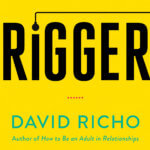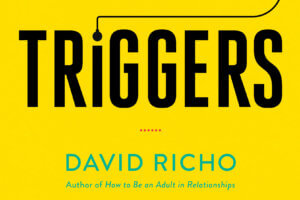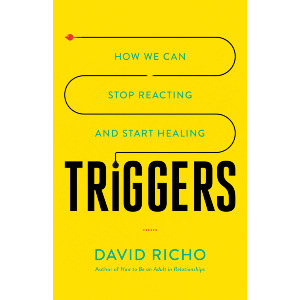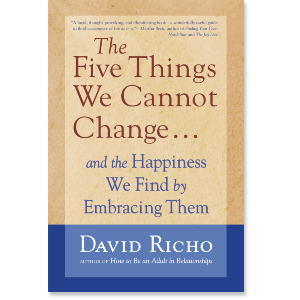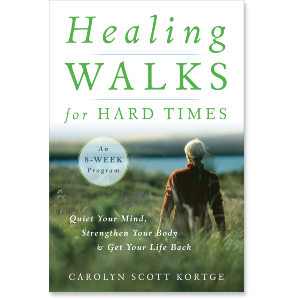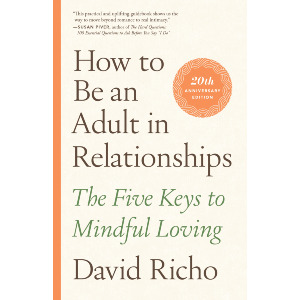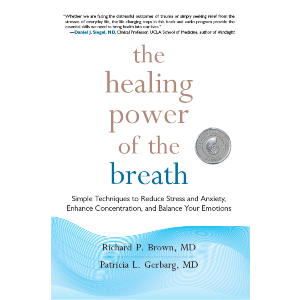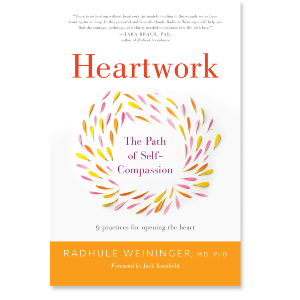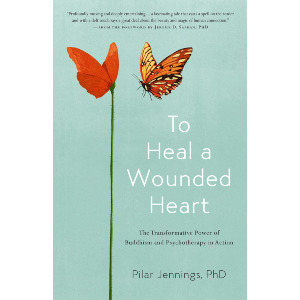An excerpt from Triggers
Building Trust
Partners in romantic relationships naturally trigger one another. This follows from the fact that our choice of a partner has so much to do with transference from our past. We often unconsciously choose a partner who reminds us of the parent with whom we have unfinished emotional business, hoping to work out as adults what we could not work out in childhood. We are often triggered by something a partner says or does because it has resurrected a pattern of abuse, distress, or unfinished emotional concerns from our past. We might say that the part has triggered the whole. That explains why our reaction is overblown. It also shows us the real issue a trigger points to: the need for our own work on our own past. When we do this work, we still speak up about what triggered us in our relationship. What changes is that we do it in a matter-of-fact way. We are reporting an impact, not heaping blame and pouring out vitriol, not triggering our partner but communicating with her; this is an act of love.
We don’t have to fall back on using a trigger finger in our relationships; we can move away from being at the mercy of triggers. An essential feature of healthy communication is to know one another’s triggers. We tell one another from the very beginning of the relationship what our triggers are. Then our partner can avoid going there, or he or she can help us work on the issues from our own past that activate our trigger reactions.
Once we know each other’s triggers we agree not to pull them. This builds trust: “I can be vulnerable by telling you my trigger points, what my buttons are, and you will not use that information to push my buttons.” To know what triggers the other and to use that information to manipulate or frustrate him or her is the style of a toxic partnership, not the style of a loving one.
We can distinguish two kinds of triggers that appear especially in relationships. The first trigger is one that a partner pulls purposely to annoy or hurt the other, with a malicious or mean intent. In this instance, the triggering partner may later feel appropriate guilt and can make amends. The second kind of trigger is one that is simply a given of life, a possibility that is implicit in any relationship. For instance, one partner announces her desire to break up. The other partner is triggered, but a breakup is something that can happen to anyone; it can be an ending with no intent to hurt. The partner who is leaving needs to feel no guilt, only grief and compassion.
When we are triggered, we tell our partner that it is happening and where it comes from, and we can ask for help getting ourselves back on the matter-of-fact track and off the trigger mode. That kind of communication is another way to show healthy vulnerability and build trust. Such vulnerability is not self-victimization, but courage.
We are reporting an impact, not heaping blame and pouring out vitriol, not triggering our partner but communicating with her; this is an act of love.
We usually treat triggers entirely as interactions: “You triggered me, and you are to blame.” We can instead look for our inner reactions: What happened in us during the interaction? The partner who triggers us is then a more minor player in our drama. Blaming is always an avoidance of our own work, whether that work involves looking into ourselves or making a decision about where to go from here. Blaming means that the ball is never in our court, which is a no-win game.
Attention and Respect
A trigger is subjective most of the time. When one partner is triggered, the other cannot discount the impact of what he said or did simply by protesting “I did not mean it that way.” Our personal list of trigger points calls for respect from our partner because they are real for us—but that respect works in reverse, as well. If our partner tells us she is triggered by what we said or did, we cannot reply, “That doesn’t make sense. That should not have triggered you!” In a respectful relationship, any trigger reported by a partner should evoke attention and respect. It does not have to be logical to us. Indeed, all of us, anyone, can feel anxiety sometimes out of nowhere, for no logical reason. Our compassion grows when we see that triggers work the same way.
On the other side, the partner who was triggered may become strident and repetitive about her pain when it is dismissed as illogical. Conflict persists in relationships from such frustrating interactions. Hearing and being heard go a long way toward healing. So can an “Ouch!” and an “Oops!”
Partners can foster an attitude of taking care of one another’s triggers whenever possible: For instance, one partner is triggered by dishes left in the sink, so the other makes sure to wash them consistently. One partner is triggered by going to the dentist, so the other partner goes to the appointment with her.
When a partner triggers us we can override our reaction and go directly to what she is saying, feeling, needing. We put aside the personal hurt or defense the trigger would normally evoke in us. For example, say a partner says something critical. We are triggered because our mother criticized us in the same way. Instead of going with the triggered reflex of anger, we swat away that old pterodactyl and focus on our partner, without complaint or comeback. Instead we become curious: We pause and direct our attention to what our partner is really saying, needing, feeling. Eventually, criticism from a partner may come through without a mother association. A statement then no longer triggers—it only informs us of where our partner is coming from. Soon we come back to what we both want to say, what we both need, what we both feel. Then, later, when we are alone, we can look at whatever personal work, especially childhood-related, we ourselves need to focus on.
Sometimes a thing that was endearing and charming in a partner’s manner or actions in the romance phase may, in the conflict stage, become quite obnoxious and triggering. And sometimes partners continually trigger each other with no letup and with no commitment to changing that style; they seem invested in only blaming one another. There is then, sadly, very little hope for the relationship to survive. Healthy relationships can only thrive when partners acknowledge and work on their triggers in a no-fault zone.
Blaming is always an avoidance of our own work, whether that work involves looking into ourselves or making a decision about where to go from here.
A partner who is triggered may come back with criticism, which then triggers the other. The healthy alternative is giving constructive feedback—such feedback is less likely to be triggering. The stress level caused by a trigger will lessen exponentially when what the other person does or says no longer hits us so hard. This lightening up of an impact is ultimately the goal in working on triggers. As we gain equanimity, we take what a partner, or anyone, says or does more in stride. We find it easier to make allowances; we no longer become so ego-affronted. When the arrow of upset does not penetrate so deeply, we are more apt to witness our relationship with patience—and even curiosity. We spend less time causing fires and putting them out, and more time on understanding one another. In this way, the even-keel relationship with its close co-captains on the ship Commitment is more likely to find clear sailing.
Some triggers are based on an image of or belief about a partner or friend implanted in us by another person. As a mindfulness practice, we can eschew such secondhand triggering, especially in familial and intimate relationships. We can commit ourselves to relate to people in our life based on our own daily experience, not on gossip about them by others. We decide not to allow others’ judgments or impressions to contaminate our relationships. We ask for the same respect toward us: “You are who you are to me only because of how I experience you. I ask that I be who I am to you based only on how you experience me.” How others are triggered can’t recruit us to abandon one another—though it may open a sincere dialogue about what we have been told.
Sometimes the problem is not being triggered to action when it is appropriate! In all my now fifty years of being a psychotherapist the single most common problem I have encountered in clients has been staying too long in a relationship, situation, job, or belief system that does not work—that is unfulfilling or even painful. We are not really staying; we are idling, not moving and wasting resources at the same time. We blunt the trigger that might lead us to change something for the better or to abandon ship. We should not feel too ashamed to undertake change when it is called for. After all, this passage in the Declaration of Independence, written in 1776, makes that very case: “All experience has shown that mankind are more disposed to suffer, while evils are sufferable, than to right themselves by abolishing the forms to which they are accustomed. But . . . it is their right, it is their duty, to throw off such government, and to provide new guards for their future security.” No one will make our changes for us. It will take “independence,” the resource in all of us, so often inactivated or, sadly, even feared. Finally, we can gently remind ourselves that trying to hold on to a relationship—or anything—beyond its expiration date does not align with the Buddha’s teaching on impermanence.
True Companions
We are social beings, so it is appropriate and praiseworthy that we enlist others to come through for us when we are in need. People share their resources with us. We then discover our own similar resources. We might say we gain from others’ strength and then can find it in ourselves. For instance, when someone stands up for us, she is showing us her assertiveness and helping us find our own voice too. When someone assists us in facing something, he is showing us how to remain present to ourselves. Such mutual support is an essential feature of friendship and intimacy. All relationships that work, intimate or otherwise, reveal and build resources. The alternative is a sense of isolation and we feel it like a punch in the stomach. The stuffing being knocked out of us is a metaphor for our store of resources being ransacked. Companionship through thick and thin, accompaniment through storm and stress—this is our vital need when the going gets rough. These are the resources a healthy relationship offers.
“She’s the one” does not necessarily forecast “We can be together successfully.” Sometimes the fact that we still love someone is used to hold us back from moving on with our own life when the other is no longer a true companion. When someone says, “My needs are not fulfilled here but I love him and therefore I will stay and endure,” love has become an excuse for an interrupted journey. The healthy adult choice in any relationship is to form connection and experience self-actualization—not one at the cost of the other. We seek to maintain the connection while simultaneously increasing an appropriate sense of our own autonomy. That is the advantage of the inner resource of self-confidence to a relationship.
It is paradoxical that we keep trying to get our needs met from those who failed us before and fail us now. We might keep trying to change reality when we are afraid of facing it. The more empowering approach is to give up trying to get our needs met from those who failed and fail us. Instead, we mourn for what isn’t there to be had, and we move on: We accept our own reality without resentment toward or censure of anyone else.
The hope for change in the other and the attempt to get our needs met when the evidence is against it happening are ways of avoiding our grief about the fact of what has been lost or missing, the fact of refusals to our requests for closeness.
The healthy adult choice in any relationship is to form connection and experience self-actualization—not one at the cost of the other.
An enduring sense of nonfulfillment shows us we have hung around too long in a ghost town. If we really want intimacy, will we find it from loitering longer in the dry saloon? What if we are simply taking turns spinning the roulette wheel? We come to know our authentic agenda in a relationship by asking searching questions of ourselves and one another, without demand or blame:
- Do we want assurance of connection but not really want to do what it takes to establish commitment or communion?
- Have we been programming our choices and responses for more closeness or more distance?
- Have we let go of our attachment to being right?
- Do we still demand that the other should change with the idea that “and then all will be OK”?
- Do we keep one another in an uncertain state so that we, or one of us, can be justified in not being in the relationship in a fully committed way?
- When ruptures occur, do we immediately move toward repair or do we resist it?
- When our partner upsets us, do we disconnect or do we simply take a time-out and then come back to address the issue?
- Can we both report thirty consecutive days of friction-free happiness? (It is not safe to discuss marriage or commitment until at least that amount of time elapses. And it is understandable to consider an end to the relationship when a stretch of happiness has not happened for longer than we can remember.)
- Have we settled for mediocrity in our relationship because life together has become so comfortable? Or are we earnestly working together to make it as good as the best it ever was?
- Is drama the real goal in the relationship rather than lying down together in green pastures to restore our souls?
- How clear, or even appealing, is Mom or Dad’s picture in the locket of our relationship?
- How are we giving and receiving the components of love, the five As, to one another?
In a healthy relationship, the five As happen most of the time in a good enough way. We don’t expect constant attunement to our needs by our partner, only moments of it. We know it is enough when the last instance was so recent that we can remember it. Misattunements are to be expected in any relationship. They happened to us in infancy when our parents missed our bids for attention to our needs. Yet, very early on we learned to recover from misattunements. That recovery is the origin of self-soothing, an inner resource now.
Attunement is responding to a need or mirroring a feeling with attention, acceptance, appreciation, affection, allowing. We attune to others’ needs and we can also attune to our own. The five As are our inner resources, reliable and enduring. With a loving focus both on ourselves and others we begin to notice our own anxieties diminish.
Finally, we can apply the five As to our practice of remaining mindfully present: We bring to the here and now an attentiveness to what it is in itself, an acceptance of it as it is, an appreciation for the opportunities to practice—the graces—that it offers, an affectionate holding of it, a full allowing of it to open in its own way—and we make allowances for our repeated failures. This is how we mirror the moment with self-compassion and thereby access its richest resources. What arises next is a calm trust in our ability to handle any old trigger.
Share
Related Books
$17.95 - Paperback
The Five Things We Cannot Change
$14.95 - Paperback
$24.95 - Paperback
How to Be an Adult in Relationships
$18.95 - Paperback
The Healing Power of the Breath
$19.95 - Paperback
$16.95 - Paperback
$18.95 - Paperback


